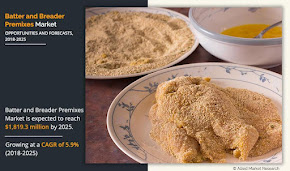Feed Phosphate Market Expected to Reach $3.3 Billion by 2031
According to a new report published by Allied Market Research, titled, “Feed Phosphate Market," The feed phosphate market was valued at $2.2 billion in 2021 and is estimated to reach $3.3 billion by 2031, growing at a CAGR of 4% from 2022 to 2031.
The market
for feed phosphate is mostly driven by an increase in meat processing
industrialization. Meat processing has been an industrialized sector, which
benefits consumers financially. Industrialization of meat processing is expected
to continue to be the most sought-after benefit for years to come as beef and
other meat products now cost less than half what they did a century ago.
Furthermore, the high threat of diseases in livestock is expected to fuel the
feed phosphate market. Diseases such as avian flu, BSE (bovine spongiform
encephalopathy), and SARS (severe acute respiratory syndrome) pose a
substantial risk to human health in addition to having an impact on animal
breeding and the economy. Swine farmers suffered huge losses as a result of the
spread of swine diarrhea in the U.S. In addition, due to the hot and humid
climate, nations such as China, India, and Indonesia are frequently dealing
with avian flu and swine flu outbreaks. Thus, such factors contribute to the growth
of the feed phosphate market share.
Download Free Sample Copy@ https://www.alliedmarketresearch.com/request-sample/17258
In
addition, the majority of companies in the feed phosphates industry create feed
phosphate from phosphate rock, a limited resource, using a procedure that is
similar for all of their products. To assure a steady supply of high-quality
phosphates for the feed business, however, market participants must make
R&D investments, develop creative production methods, and find new sources
of phosphorus. Phosphorus recovery technology has undergone a sizable number of
advancements in recent years. For the recovery of phosphorus, a number of
techniques can be used, such as chemical precipitation, biological phosphorus
removal, crystallization, and innovative chemical precipitation approaches, the
most recent of which is the wet-chemical process utilizing fly ash.
On the
other side, due to the high cost of phosphate salts, such as monocalcium and
dicalcium phosphates, replacements such as phytase, which are less expensive
and may be used to reduce the overall feed cost, have become more popular. More
than 90% of poultry diets and over 70% of swine diets contain phytase,
according to Danisco Animal Nutrition (UK), the feed subsidiary of E. I. du
Pont de Nemours and Company (US). The same source claims that phytase has
assisted the feed business in saving USD 2 billion annually on feed input and
nutritional expenditures.
According
to feed phosphate market opportunities, on the basis of type, the market is
classified into dicalcium, monocalcium, mono-dicalcium, defluorinated, and
tricalcium. The dicalcium segment accounted for a major share in the feed
phosphates market in 2021 and is expected to suatin its share throughout feed
phosphate market forecast period. Dicalcium phosphate is a white, unscented
powder with the chemical formula CaHPO4. It is also known as dibasic calcium
phosphate or calcium monohydrate phosphate. It is one of the sources of mineral
phosphorus that is frequently used in healthy eating plans.
On the
basis of livestock, the poultry segment accounted for a major share in the
product market in 2021 and is expected to grow at a significant CAGR during the
forecast period. Feed phosphate is majorly used in poultry owing to its ability
to replenish phosphorous, which contributes to the formation of a strong
skeleton & tissue, improves metabolism & reproductive system functions,
and increases productivity. In addition, an increase in poultry farming and a
rise in poultry meat consumption both boost the need for feed phosphate..
According
to feed phosphate market analysis, by form, the powder segment was the highest
contributor to the market, with $1,575.2 million in 2021 and is expected grow
at a CAGR of 3.8% during the forecast period. Powder form of the feed phosphate
is significantly used owing to flowability, spreadability, and packing
characteristics within a machine.
According to feed phosphate market trends, Europe product market accounted for
22.9% share in the feed phosphate market in 2021 and is expected to maintain
its share during the forecast period. Growth in production and consumption of
meat and meat products are likely to contribute to the growth of the market
during the forecast period. Meat is an important segment of the European
agricultural sector. The EU's policies encourage animal producers to use
healthy and nutrient-rich feed additives while balancing their environmental
impact, driving the feed phosphate market growth
The players
operating in the global feed phosphate industry have adopted various
developmental strategies to expand their market share, increase profitability,
and remain competitive in the market. The key players profiled in this report
are The Mosiac Company, PhosAgro, EuroChem Group, Nutrien Ltd., Rotem, AB
LIFOSA, Reanjoy Laboratories, Yara International ASA, Fosfitalia Group, and OCP
Group.
Key
findings of the study:
·
The feed
phosphate market size was valued at $2,226.6 million in 2021, and is estimated
to reach $3,270.3 million by 2031, registering a CAGR of 4.0% from 2022 to
2031.
·
In 2021, on
the basis of type, the dicalcium segment acquired $869.7 million, exhibiting
39.1% of the global market share.
·
In 2021, on
the basis of livestock, the poultry segment acquired $860.0 million, exhibiting
38.6% of the global market share.
·
China was
the most prominent market in Asia-Pacific in 2021, and is projected to reach
$232.7 million by 2031, growing at a CAGR of 2.3% during the forecast period.
Request
For Customization@ https://www.alliedmarketresearch.com/request-for-customization/17258
Contact
us:
David
Correa
Allied
Analytics LLP
+1-800-792-5285




Comments
Post a Comment